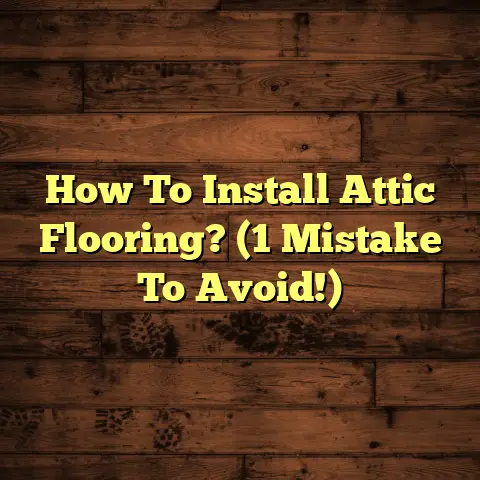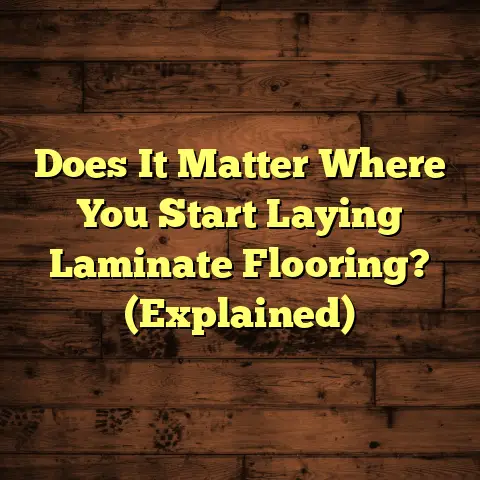Safely Clean Hardwood Floors? (1 Tip Pro’s Use!)
(1 Tip Pro’s Use!)
Imagine this: the morning sun streams into your living room, highlighting the warm, inviting glow of your hardwood floors.
The scent of coffee fills the air, and a sense of calm washes over you. Your floors aren’t just a surface; they’re the foundation of your home’s beauty and comfort.
But let’s be real, life happens. Kids, pets, muddy shoes – they all take a toll. How do you keep your hardwood floors looking their best without damaging them?
As a flooring contractor for over 15 years, I’ve seen it all. Floors ruined by harsh chemicals, scratched by abrasive tools, and dulled by improper cleaning.
That’s why I’m going to share the one tip that pros like me swear by: using a microfiber mop with a pH-neutral cleaner. Trust me, it’s a game-changer.
Understanding Hardwood Floors
First, let’s talk about hardwood itself. Did you know there’s more to it than just “wood”? There are two main types: solid hardwood and engineered hardwood.
Solid hardwood is exactly what it sounds like: one solid piece of wood. It’s beautiful, durable, and can be refinished multiple times. Think classic, timeless appeal.
Engineered hardwood, on the other hand, is made of layers of wood, with a hardwood veneer on top. It’s more resistant to moisture and temperature changes, making it a great option for basements or areas with high humidity.
Now, let’s get to the finish. This is where things get really important when it comes to cleaning. The finish is the protective layer on top of the wood, and it determines how you should clean your floors.
-
Polyurethane: This is the most common finish. It’s durable, water-resistant, and easy to clean. Most modern hardwood floors have a polyurethane finish.
-
Oil-Based Finishes: These finishes penetrate the wood and provide a natural look and feel. They require special cleaning products designed for oiled floors.
-
Wax Finishes: These are less common these days, but you might find them in older homes. Waxed floors need to be waxed regularly and cleaned with specific wax-friendly cleaners.
Why does all this matter? Because using the wrong cleaning product on the wrong finish can damage your floors. I’ve seen it happen way too many times.
Hardwood floors aren’t just beautiful; they also add value to your home. According to the National Association of Realtors, 99% of realtors believe hardwood flooring increases home value and are easier to keep clean than carpet. [^1]
Common Issues with Hardwood Floors
So, what are the biggest threats to your hardwood floors? Let’s break it down:
-
Scratches: These are inevitable, especially if you have kids or pets. They can range from minor surface scratches to deep gouges.
-
Stains: Spills happen. Coffee, wine, pet accidents – they can all leave unsightly stains if not cleaned up quickly.
-
Dullness: Over time, the finish on your hardwood floors can become dull and lifeless. This is often caused by dirt, grime, and improper cleaning products.
-
Water Damage: This is a big one. Water can seep into the wood, causing it to swell, warp, or even rot. Leaky appliances, plumbing issues, and excessive moisture are all culprits.
Climate and humidity also play a huge role. Wood expands and contracts with changes in humidity. In dry climates, hardwood floors can shrink and crack. In humid climates, they can swell and warp.
Foot traffic and pets are another major factor. High-traffic areas like hallways and entryways tend to wear down faster. And pets? Well, their claws can wreak havoc on your floors.
I remember one client who had beautiful hardwood floors throughout their home. They had two large dogs who loved to run and play. Over time, their floors became covered in scratches and scuff marks. It was a costly repair, but preventable.
The Importance of a Cleaning Routine
Think of your hardwood floors like your teeth. If you don’t brush them regularly, plaque builds up, and you end up with cavities. The same goes for your floors.
A regular cleaning routine prevents dirt, dust, and grime from accumulating and damaging the finish. It also helps to maintain the shine and beauty of your floors.
Neglect can lead to bigger problems down the road. Dirt and grime can grind into the finish, causing scratches and dullness. Stains can become permanent. And water damage can lead to costly repairs.
Preventive maintenance is key. By establishing a simple cleaning routine, you can extend the life of your hardwood floors and keep them looking their best for years to come.
I always tell my clients that a little bit of maintenance goes a long way. A quick sweep or vacuum a few times a week, followed by a damp mop, can make a huge difference.
The One Pro Tip for Safe Cleaning
Alright, here it is – the pro tip you’ve been waiting for: Use a microfiber mop with a pH-neutral cleaner.
Why microfiber? Because it’s gentle on the surface of your floors. Unlike traditional mops, microfiber mops are made of tiny, soft fibers that won’t scratch or damage the finish.
They’re also incredibly effective at trapping dirt, dust, and grime. The fibers act like tiny hooks, grabbing onto particles and lifting them away from the floor.
And pH-neutral cleaners? These are specially formulated to be gentle on hardwood floors. They won’t strip the finish, dull the shine, or leave behind a sticky residue.
Many cleaners are too acidic or alkaline, which can damage the finish over time. pH-neutral cleaners, on the other hand, are balanced to protect the finish while effectively cleaning the floor. The pH scale ranges from 0-14, with 7 being neutral. Anything below 7 is acidic, and anything above 7 is alkaline.
Think of it this way: using a harsh cleaner on your hardwood floors is like using sandpaper on your skin. It might get the job done, but it’s going to leave you with damage in the long run.
I always recommend that my clients use a pH-neutral cleaner specifically designed for hardwood floors. Look for products that are labeled as “pH-neutral” or “safe for hardwood floors.”
Step-by-Step Guide to Cleaning Hardwood Floors Safely
Okay, let’s get down to the nitty-gritty. Here’s a step-by-step guide to cleaning your hardwood floors safely using the pro tip:
-
Gather Your Supplies: You’ll need a microfiber mop, a pH-neutral cleaner, a bucket, and a vacuum or broom.
-
Prepare the Floor: Remove any furniture from the area you’re going to clean. Sweep or vacuum the floor to remove any loose dirt, dust, or debris.
-
Dilute the Cleaner: Follow the instructions on the cleaner bottle to dilute it properly. Most pH-neutral cleaners require you to mix a small amount of cleaner with water.
-
Apply the Cleaner: Dip the microfiber mop into the cleaning solution and wring it out thoroughly. You want the mop to be damp, not soaking wet.
-
Mop the Floor: Using light pressure, mop the floor in the direction of the wood grain. Avoid using too much water, as this can damage the wood.
-
Rinse the Mop: As you mop, rinse the microfiber mop in the bucket of clean water to remove any dirt or grime. Wring it out thoroughly before continuing.
-
Allow to Dry: Once you’ve mopped the entire floor, allow it to air dry completely. This usually takes about 30 minutes to an hour.
-
Reintroduce Furniture: Once the floor is completely dry, you can reintroduce the furniture. Be careful not to scratch the floor as you move the furniture back into place.
I always tell my clients to test the cleaner in an inconspicuous area first to make sure it doesn’t damage the finish. This is especially important if you’re using a new cleaner for the first time.
And remember, less is more. You don’t need to saturate the floor with cleaner to get it clean. A damp mop is all you need.
Additional Tips for Maintaining Hardwood Floors
Beyond regular cleaning, here are a few additional tips to keep your hardwood floors looking their best:
-
Occasional Deep Cleaning: Every few months, you may want to do a more thorough deep cleaning. This involves using a specialized hardwood floor cleaner and a scrubbing mop to remove stubborn dirt and grime.
-
Use Rugs and Mats: Place rugs and mats in high-traffic areas like entryways, hallways, and kitchens. This will help to protect the floors from scratches and wear and tear.
-
Humidity Control: Maintain a consistent humidity level in your home to prevent the wood from expanding and contracting. Use a humidifier or dehumidifier as needed. According to the EPA, ideal humidity levels are between 30-50%. [^2]
-
Avoid Harsh Chemicals: Never use harsh chemicals like bleach, ammonia, or vinegar on your hardwood floors. These can damage the finish and dull the shine.
-
Trim Pet Nails: Keep your pet’s nails trimmed to prevent them from scratching the floors.
-
Use Furniture Pads: Place felt pads under the legs of your furniture to prevent scratches.
I had one client who was constantly complaining about scratches on their hardwood floors. I suggested that they put felt pads under the legs of their furniture, and it made a huge difference. They were amazed at how much it helped to protect their floors.
Conclusion
Maintaining the beauty and longevity of your hardwood floors doesn’t have to be a chore. By following the pro tip of using a microfiber mop with a pH-neutral cleaner, you can keep your floors looking pristine for years to come.
Remember, a little bit of preventive maintenance goes a long way. Establish a regular cleaning routine, use the right products, and take care to protect your floors from scratches and water damage.
Your hardwood floors are an investment in your home. By taking care of them properly, you can enjoy their beauty and warmth for generations to come.
So, go ahead and adopt this cleaning practice. Your floors (and your home) will thank you for it!
[^1]: National Association of Realtors. “Hardwood Flooring: A Timeless Investment.” Real Estate Today, https://www.nar.realtor/
[^2]: Environmental Protection Agency (EPA). “Care for your home.” EPA, https://www.epa.gov/





